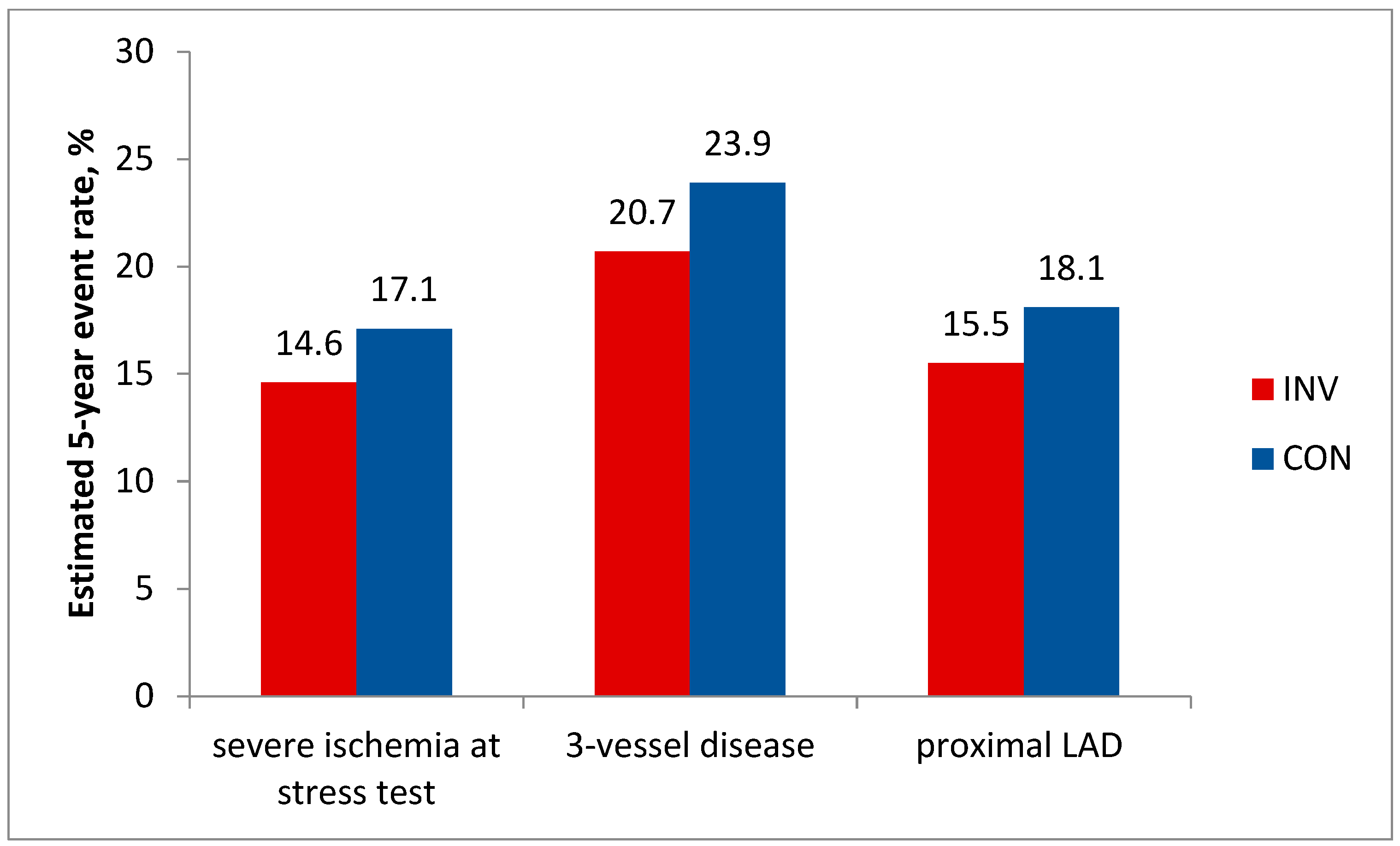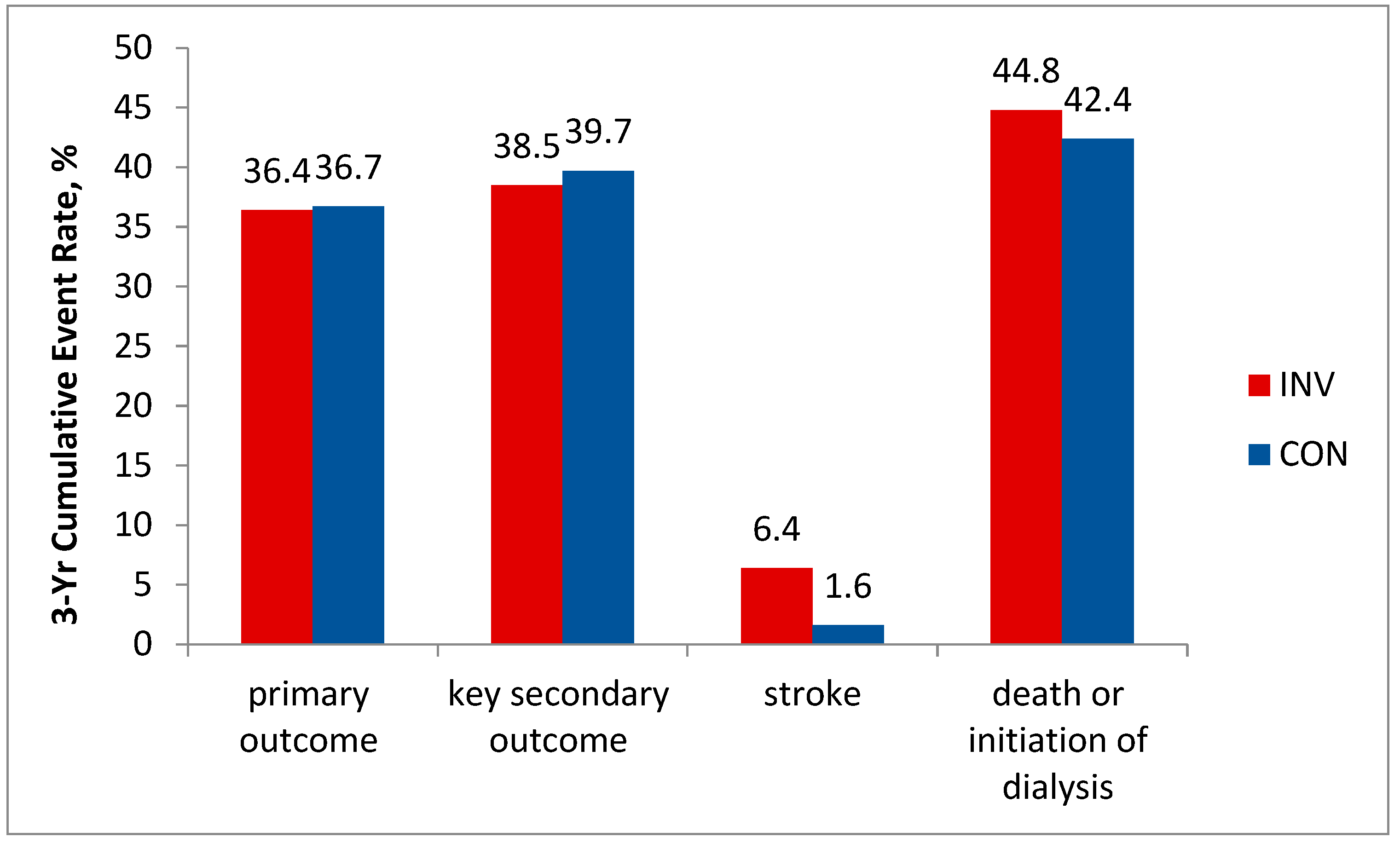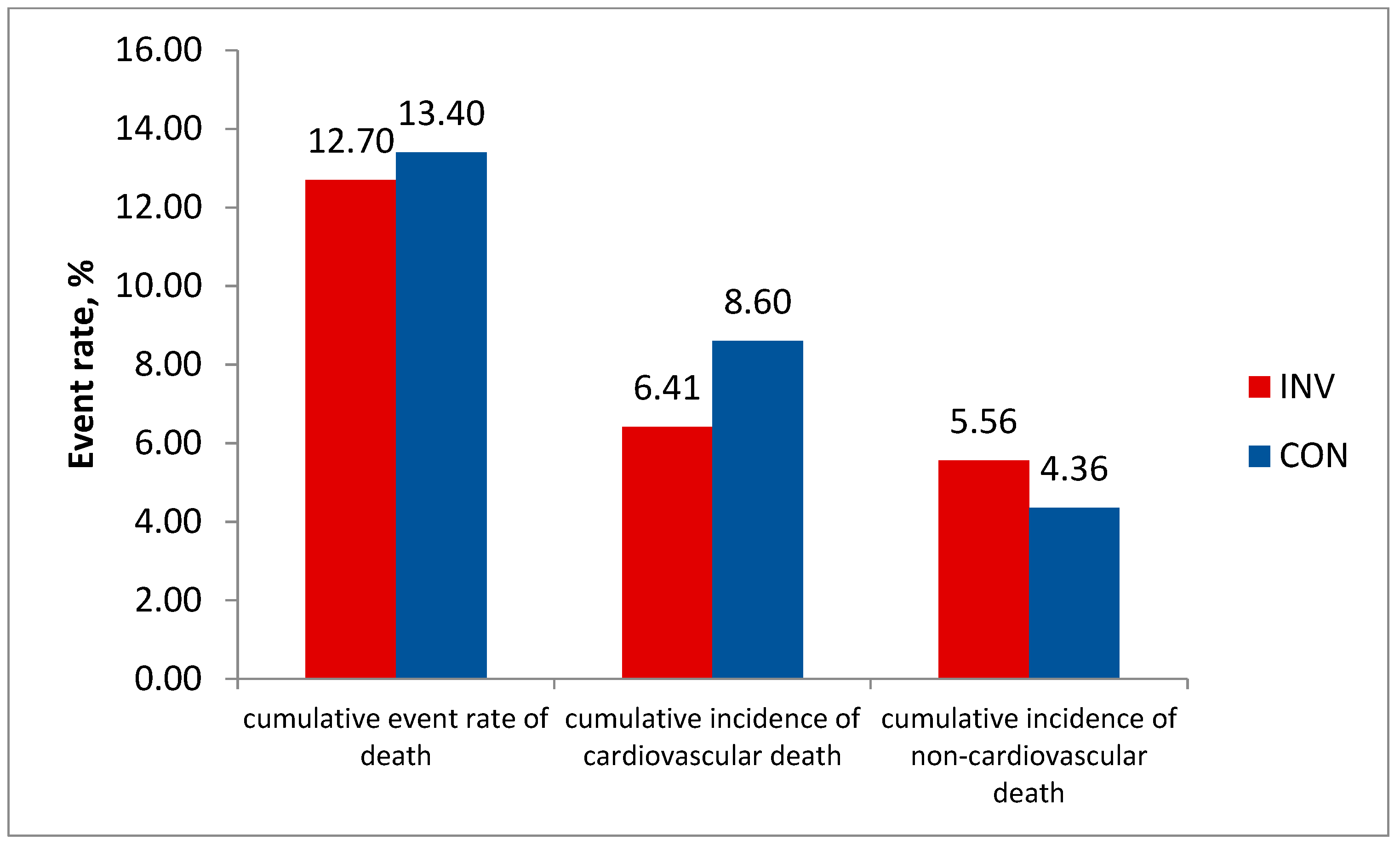Stable Coronary Artery Disease: Who Finally Benefits from Coronary Revascularization in the Modern Era? The ISCHEMIA and Interim ISCHEMIA-EXTEND Analysis
Abstract
1. Introduction
2. Summary of Guidelines on Myocardial Revascularization before ISCHEMIA
3. Myocardial Revascularization: Evidence from the ISCHEMIA Trial
3.1. Myocardial Revascularization in SCAD and Prognosis
3.2. Analysis of the Severity of Ischemia during a Stress Test and the Severity of Coronary Disease as Predictors of the Prognostic Benefit of an Invasive Strategy
4. ISCHEMIA-CKD
5. Interim Results of ISCHEMIA-EXTEND
Myocardial Revascularization and Symptoms of Ischemia in SCAD
6. Discussion
6.1. ISCHEMIA Advantages
- Randomization occurred in the absence of information about the coronary angiography data, resulting in the inclusion of a significant number of patients with high-risk lesions;
- Moderately or strongly positive stress tests were the inclusion criterion. As a result, ISCHEMIA patients were quite “ill” as judged by the results of the stress test (in contrast to the COURAGE trial participants [26]), while in such patients the invasive strategy should theoretically have the greatest advantage over the conservative one [3];
- Only second-generation drug-eluting stents were used, and FFR was assessed in borderline lesions. As a result, revascularization of physiologically significant lesions was performed in most cases, similar to the FAME 2 study, which showed the prognostic advantage of an invasive strategy with this approach [11];
- As a method of revascularization, both PCI and CABG were used, the latter with mammary grafts as a rule (PCI only in COURAGE and FAME 2);
- For the diagnosis of unstable angina during follow-up, objective confirmation was required, the absence of which is considered the reason for the debatable results of the FAME 2 study [10];
- As a result, high-risk patients were included both in terms of functional and anatomical criteria, and invasive treatment was carried out at the optimal modern level. At the same time, even by the end of the follow-up, OMT was not ideal, with only 41% of patients receiving “true” OMT, and the target LDL-C value was more liberal than at present.
- An invasive strategy, compared with a conservative strategy, did not result in a lower risk of the primary endpoint;
- Low mortality was observed with both strategies, including the conservative strategy, in the population of patients with severe coronary artery disease. It was 5.5% per 3.2 years of follow-up, i.e., about 1.7%/year—which is about half as much as calculated for patients of this risk level on the stress test [7];
- Invasive strategies showed no prognostic benefit in the prespecified important subgroups (strongly positive stress test; 3-vessel disease; proximal LAD disease). The advantage of an invasive strategy in the prevention of spontaneous AMI could be shown;
- An advantage of an invasive strategy in reducing the symptoms of ischemia has been shown.
6.2. ISCHEMIA Limitations
6.2.1. Methodology and Enrollment
- Due to slow enrollment, the sample size had to be reduced from the originally planned 8,000 to approximately 5,000. Consequently, the primary endpoint was expanded from the cumulative of cardiovascular death or MI to a 5-component outcome to maintain statistical power [27]. However, the authors clearly indicated that the plan to adopt the 5-component primary endpoint if aggregate, blinded accruing data demonstrated a lower than expected event rate was finalized, approved by the Data Monitoring Board, and included in the original protocol version before any patients were enrolled in the trial [28];
- A high proportion of enrolled subjects in ISCHEMIA were asymptomatic or mildly symptomatic [25]. In our opinion, it could contribute to the higher exercise capacity at the stress test shown in ISCHEMIA (median 7.8 MET) [15] than it would be in a more symptomatic population. Such high exercise capacity probably does not reflect the typical profile of SCAD patients being referred to angiography and constitutes the study limitation;
- The patients inclusion was based on the stress test analysis performed locally to better reflect real clinical practice, which led to ≈15% having less than moderate ischemia according to the core laboratory review [19]. This fact resulted in somewhat exaggerated ischemia severity reported in the enrolled patients;
- As in patients with eGFR < 60 mL/min, CCTA was not performed, the coronary anatomy data was available only in 48% of the enrolled patients [19], which reduced the power of the related analyses;
- Patients with lesions of the LMCA and those with EF < 35%, as well as those with end-stage CKD, were not included in the study. At the same time, according to the analysis of the American Cardiovascular Data Registry (NCDR), among patients with SCAD undergoing PCI, 18.5% have a decreased EF, left main disease, or CKD stage 5 [29]. It should be noted that patients with LMCA have also been excluded from the key RCTs (COURAGE, BARI-2D, and FAME II) studying patients with SCAD, while the key trials comparing PCI and CABG in patients with LMCA (EXCEL, PRECOMBAT, and NOBLE) have shown conflicting results [6]. At the same time, the question of the appropriateness of revascularization to improve prognosis in patients with severe CKD was answered (negatively) in the ISCHEMIA-CKD sub-study;
- The requirements for the PCI procedure (intravascular imaging, plaque modification, implementation of FFR measurement, and completeness of revascularization) were not imposed by the protocol but left to the choice of the operator. This could have led to a non-universal approach to what was considered “revascularization” in the invasive arm and a heterogeneous ultimate revascularization quality;
- The crossover from the conservative arm to the invasive arm resulted in 21% of patients assigned to the conservative arm undergoing elective revascularization. Though this proportion is sizeable, the yearly crossover rate in ISCHEMIA was 6.6%, similar to the rate in COURAGE (7.2%) [16].
6.2.2. Results
6.3. ISCHEMIA Results Compared to Other New Research Data
7. Conclusions
Author Contributions
Funding
Institutional Review Board Statement
Informed Consent Statement
Data Availability Statement
Conflicts of Interest
References
- Authors/Task Force Members; Windecker, S.; Kolh, P.; Alfonso, F.; Collet, J.P.; Cremer, J.; Falk, V.; Filippatos, G.; Hamm, C.; Head, S.J.; et al. 2014 ESC/EACTS Guidelines on myocardial revascularization: The Task Force on Myocardial Revascularization of the European Society of Cardiology (ESC) and the European Association for Cardio-Thoracic Surgery (EACTS)Developed with the special contribution of the European Association of Percutaneous Cardiovascular Interventions (EAPCI). Eur. Heart J. 2014, 35, 2541–2619. [Google Scholar] [CrossRef]
- Neumann, F.J.; Sousa-Uva, M.; Ahlsson, A.; Alfonso, F.; Banning, A.P.; Benedetto, U.; Byrne, R.A.; Collet, J.P.; Falk, V.; Head, S.J.; et al. 2018 ESC/EACTS Guidelines on myocardial revascularization. Eur. Heart J. 2019, 40, 87–165. [Google Scholar] [CrossRef] [PubMed]
- Knuuti, J.; Wijns, W.; Saraste, A.; Capodanno, D.; Barbato, E.; Funck-Brentano, C.; Prescott, E.; Storey, R.F.; Deaton, C.; Cuisset, T.; et al. 2019 ESC Guidelines for the diagnosis and management of chronic coronary syndromes. Eur. Heart J. 2020, 41, 407–477. [Google Scholar] [CrossRef] [PubMed]
- Lopez-Sendon, J.; Moreno, R.; Tamargo, J. ISCHEMIA Trial: Key Questions and Answers. Eur. Cardiol. 2021, 16, e34. [Google Scholar] [CrossRef] [PubMed]
- Kanoun Schnur, S.S.; Achim, A.; Toth, G.G. Clinical application of results of the ISCHEMIA trial. Trends Cardiovasc. Med. 2023, 33, 125–130. [Google Scholar] [CrossRef]
- Kohsaka, S.; Ejiri, K.; Takagi, H.; Watanabe, I.; Gatate, Y.; Fukushima, K.; Nakano, S.; Hirai, T. Diagnostic and Therapeutic Strategies for Stable Coronary Artery Disease Following the ISCHEMIA Trial. JACC Asia 2023, 3, 15–30. [Google Scholar] [CrossRef]
- Fihn, S.D.; Gardin, J.M.; Abrams, J.; Berra, K.; Blankenship, J.C.; Dallas, A.P.; Douglas, P.S.; Foody, J.M.; Gerber, T.C.; Hinderliter, A.L.; et al. 2012 ACCF/AHA/ACP/AATS/PCNA/SCAI/STS Guideline for the diagnosis and management of patients with stable ischemic heart disease: A report of the American College of Cardiology Foundation/American Heart Association Task Force on Practice Guidelines, and the American College of Physicians, American Association for Thoracic Surgery, Preventive Cardiovascular Nurses Association, Society for Cardiovascular Angiography and Interventions, and Society of Thoracic Surgeons. J. Am. Coll. Cardiol. 2012, 60, e44–e164. [Google Scholar] [CrossRef]
- Bershteyn, L.L.; Andreeva, A.E.; Katamadze, N.O.; Zbyshevskaya, E.V.; Kuzmina-Krutetskaya, A.M.; Volkov, A.V.; Gumerova, V.E.; Bitakova, F.I.; Sayganov, S.A. ISCHEMIA—The Largest Ever Randomized Study in Stable Coronary Artery Disease. Baseline Characteristics of Enrolled Patients in One Russian Site. Kardiologiia 2017, 57, 12–19. [Google Scholar] [CrossRef]
- Stergiopoulos, K.; Boden, W.E.; Hartigan, P.; Möbius-Winkler, S.; Hambrecht, R.; Hueb, W.; Hardison, R.M.; Abbott, J.D.; Brown, D.L. Percutaneous coronary intervention outcomes in patients with stable obstructive coronary artery disease and myocardial ischemia: A collaborative meta-analysis of contemporary randomized clinical trials. JAMA Intern. Med. 2014, 174, 232–240. [Google Scholar] [CrossRef]
- Rajkumar, C.A.; Nijjer, S.S.; Cole, G.D.; Al-Lamee, R.; Francis, D.P. ‘Faith Healing’ and ‘Subtraction Anxiety’ in Unblinded Trials of Procedures: Lessons from DEFER and FAME-2 for End Points in the ISCHEMIA Trial. Circ. Cardiovasc. Qual. Outcomes 2018, 11, e004665, Erratum in Circ Cardiovasc. Qual Outcomes 2018, 11, e000038. [Google Scholar] [CrossRef]
- Xaplanteris, P.; Fournier, S.; Pijls, N.H.; Fearon, W.F.; Barbato, E.; Tonino, P.A.; Engstrøm, T.; Kääb, S.; Dambrink, J.-H.; Rioufol, G.; et al. Five-Year Outcomes with PCI Guided by Fractional Flow Reserve. N. Engl. J. Med. 2018, 379, 250–259. [Google Scholar] [CrossRef] [PubMed]
- Little, W.C. Angiographic assessment of the culprit coronary artery lesion before acute myocardial infarction. Am. J. Cardiol. 1990, 66, 44G–47G. [Google Scholar] [CrossRef] [PubMed]
- Hochman, J.S.; Reynolds, H.R.; Bangalore, S.; O’brien, S.M.; Alexander, K.P.; Senior, R.; Boden, W.E.; Stone, G.W.; Goodman, S.G.; Lopes, R.D.; et al. Baseline Characteristics and Risk Profiles of Participants in the ISCHEMIA Randomized Clinical Trial. JAMA Cardiol. 2019, 4, 273–286. [Google Scholar] [CrossRef]
- Maron, D.J.; Hochman, J.S.; Reynolds, H.R.; Bangalore, S.; O’Brien, S.M.; Boden, W.E.; Chaitman, B.R.; Senior, R.; López-Sendón, J.; Alexander, K.P.; et al. Initial Invasive or Conservative Strategy for Stable Coronary Disease. N. Engl. J. Med. 2020, 82, 1395–1407. [Google Scholar] [CrossRef] [PubMed]
- Fleg, J.; Huang, Z.; Reynolds, H.R.; Shaw, L.; Chaitman, B.; O’Brien, S.M.; Bershtein, L.; Peteiro, J.; Smanio, P.; Wander, G.; et al. Relationships between Inducible Myocardial Ischemia Severity, Extent of Coronary Artery Disease, and Exercise Capacity in the ISCHEMIA Trial. Circulation, 2023; in press. [Google Scholar]
- Mandrola, J.M.; Kaul, S.; Foy, A. Lessons Learnt from Recent Trials in Ischemic Heart Disease. Thromb. Haemost. 2021, 121, 8–14. [Google Scholar] [CrossRef]
- Spertus, J.A.; Jones, P.G.; Maron, D.J.; O’brien, S.M.; Reynolds, H.R.; Rosenberg, Y.; Stone, G.W.; Harrell, F.E.; Boden, W.E.; Weintraub, W.S.; et al. Health-Status Outcomes with Invasive or Conservative Care in Coronary Disease. N. Engl. J. Med. 2020, 382, 1408–1419. [Google Scholar] [CrossRef]
- Chan, P.S.; Jones, P.G.; Arnold, S.A.; Spertus, J.A. Development and validation of a short version of the Seattle angina questionnaire. Circ. Cardiovasc. Qual. Outcomes 2014, 7, 640–647. [Google Scholar] [CrossRef]
- Reynolds, H.R.; Shaw, L.J.; Min, J.K.; Page, C.B.; Berman, D.S.; Chaitman, B.R.; Picard, M.H.; Kwong, R.Y.; O’brien, S.M.; Huang, Z.; et al. Outcomes in the ISCHEMIA Trial Based on Coronary Artery Disease and Ischemia Severity. Circulation 2021, 44, 1024–1038. [Google Scholar] [CrossRef]
- Sarnak, M.J.; Amann, K.; Bangalore, S.; Cavalcante, J.L.; Charytan, D.M.; Craig, J.C.; Gill, J.S.; Hlatky, M.A.; Jardine, A.G.; Landmesser, U.; et al. Chronic Kidney Disease and Coronary Artery Disease: JACC State-of-the-Art Review. J. Am. Coll. Cardiol. 2019, 74, 1823–1838. [Google Scholar] [CrossRef]
- Lawton, J.S.; Tamis-Holland, J.E.; Bangalore, S.; Bates, E.R.; Beckie, T.M.; Bischoff, J.M.; Bittl, J.A.; Cohen, M.G.; DiMaio, J.M.; Don, C.W.; et al. 2021 ACC/AHA/SCAI Guideline for Coronary Artery Revascularization: Executive Summary: A Report of the American College of Cardiology/American Heart Association Joint Committee on Clinical Practice Guidelines. Circulation 2022, 145, e4–e17. [Google Scholar] [CrossRef] [PubMed]
- Bangalore, S.; Maron, D.J.; O’brien, S.M.; Fleg, J.L.; Kretov, E.I.; Briguori, C.; Kaul, U.; Reynolds, H.R.; Mazurek, T.; Sidhu, M.S.; et al. Management of Coronary Disease in Patients with Advanced Kidney Disease. N. Engl. J. Med. 2020, 382, 1608–1618. [Google Scholar] [CrossRef] [PubMed]
- Hochman, J.S.; Anthopolos, R.; Reynolds, H.R.; Bangalore, S.; Xu, Y.; O’brien, S.M.; Mavromichalis, S.; Chang, M.; Contreras, A.; Rosenberg, Y.; et al. Survival After Invasive or Conservative Management of Stable Coronary Disease. Circulation 2023, 147, 8–19. [Google Scholar] [CrossRef] [PubMed]
- Sidhu, M.S.; Alexander, K.P.; Huang, Z.; O’Brien, S.M.; Chaitman, B.R.; Stone, G.W.; Newman, J.D.; Boden, W.E.; Maggioni, A.P.; Steg, P.G.; et al. Causes of cardiovascular and noncardiovascular death in the ISCHEMIA trial. Am. Heart J. 2022, 248, 72–83. [Google Scholar] [CrossRef]
- Ianni, U.; Radico, F.; Ricci, F.; Perfetti, M.; Archilletti, F.; Renda, G.; Maddestra, N.; Gallina, S.; Zimarino, M. The legacy of ISCHEMIA. Cardiol. J. 2020, 27, 329–335. [Google Scholar] [CrossRef]
- Boden, W.E.; O’Rourke, R.A.; Teo, K.K.; Hartigan, P.M.; Maron, D.J.; Kostuk, W.J.; Knudtson, M.; Dada, M.; Casperson, P.; Harris, C.L.; et al. Optimal medical therapy with or without PCI for stable coronary disease. N. Engl. J. Med. 2007, 356, 1503–1516. [Google Scholar] [CrossRef]
- Jafary, F.H.; Jafary, A.H. Ischemia Trial: Does the Cardiology Community Need to Pivot or Continue Current Practices? Curr. Cardiol. Rep. 2022, 24, 1059–1068. [Google Scholar] [CrossRef]
- Bangalore, S.; Maron, D.J.; Reynolds, H.R.; Stone, G.W.; O’brien, S.M.; Alexander, K.P.; Hochman, J.S.; Kazi, D.S.; Hlatky, M.A.; Hacke, W.; et al. ISCHEMIA: Establishing the Primary End Point. Circ. Cardiovasc. Qual. Outcomes 2018, 11, e004791. [Google Scholar] [CrossRef]
- Available online: https://scai.confex.com/scai/2021/meetingapp.cgi/Paper/14413 (accessed on 3 May 2023).
- Chatterjee, S.; Fanaroff, A.C.; Parzynski, C.; Curtis, J.; Kolansky, D.M.; Maddox, T.M.; Mukherjee, D.; Yeh, R.W.; Giri, J. Comparison of Patients Undergoing Percutaneous Coronary Intervention in Contemporary U.S. Practice with ISCHEMIA Trial Population. JACC Cardiovasc. Interv. 2021, 14, 2344–2349. [Google Scholar] [CrossRef]
- Chacko, L.; Howard, J.P.; Rajkumar, C.; Nowbar, A.N.; Kane, C.; Mahdi, D.; Foley, M.; Shun-Shin, M.; Cole, G.; Sen, S.; et al. Effects of Percutaneous Coronary Intervention on Death and Myocardial Infarction Stratified by Stable and Unstable Coronary Artery Disease: A Meta-Analysis of Randomized Controlled Trials. Circ. Cardiovasc. Qual. Outcomes 2020, 13, e006363. [Google Scholar] [CrossRef] [PubMed]
- Achim, A.; Leibundgut, G. FAME 3 fails to defame coronary artery bypass grafting: What went wrong in the percutaneous coronary intervention arm? Eur. J. Cardio-Thorac. Surg. 2022, 62, ezac036. [Google Scholar] [CrossRef] [PubMed]
- Weintraub, W.S.; Hartigan, P.M.; Mancini, G.J.; Teo, K.K.; Maron, D.J.; Spertus, J.A.; Chaitman, B.R.; Shaw, L.J.; Berman, D.; Boden, W.E.; et al. Effect of Coronary Anatomy and Myocardial Ischemia on Long-Term Survival in Patients with Stable Ischemic Heart Disease. Circ. Cardiovasc. Qual. Outcomes 2019, 12, e005079. [Google Scholar] [CrossRef] [PubMed]
- Bangalore, S.; Maron, D.J.; Stone, G.W.; Hochman, J.S. Routine Revascularization Versus Initial Medical Therapy for Stable Ischemic Heart Disease: A Systematic Review and Meta-Analysis of Randomized Trials. Circulation 2020, 142, 841–857. [Google Scholar] [CrossRef] [PubMed]
- Myers, P.O.; Beyersdorf, F.; Sadaba, R.; Milojevic, M. European Association for Cardio-Thoracic Surgery Statement regarding the 2021 American Heart Association/American College of Cardiology/Society for Cardiovascular Angiography and Interventions Coronary Artery Revascularization guidelines. Eur. J. Cardiothorac. Surg. 2022, 62, ezac060. [Google Scholar] [CrossRef]
- Sabik, J.F.; Bakaeen, F.G.; Ruel, M.; Moon, M.R.; Malaisrie, S.C.; Calhoon, J.H.; Girardi, L.N.; Guyton, R. The American Association for Thoracic Surgery and The Society of Thoracic Surgeons reasoning for not endorsing the 2021 ACC/AHA/SCAI Coronary Revascularization Guidelines. J. Thorac. Cardiovasc. Surg. 2022, 163, 1362–1365. [Google Scholar] [CrossRef]




| Indication | Description |
|---|---|
| For prognosis | High risk coronary anatomy:
|
| Two-vessel disease without proximal LAD involvement in the presence of large area of inducible ischemia | |
| Left ventricular EF reduction (35–50%) | |
| History of sudden cardiac death in the presence of documented ventricular tachycardia related to ischemia | |
| For ischemic symptoms | ≥1 coronary artery stenosis (or graft stenosis in a patient after CABG) and ‘unacceptable’ angina severity despite OMT or if OMT cannot be prescribed (contraindications, side effects, patient preferences) |
| Current European Guidelines | New Research |
|---|---|
| For prognosis | |
| LMCA disease | ? |
| Proximal LAD involvement | X |
| 2- or 3-vessel disease | X |
| Large area of inducible ischemia (>10% of the left ventricle) | X |
| EF < 35% | ? |
| For ischemic symptoms | |
| Hemodynamically significant coronary artery stenosis in the presence of limiting angina or angina equivalent, with insufficient response to OMT | ✓ |
Disclaimer/Publisher’s Note: The statements, opinions and data contained in all publications are solely those of the individual author(s) and contributor(s) and not of MDPI and/or the editor(s). MDPI and/or the editor(s) disclaim responsibility for any injury to people or property resulting from any ideas, methods, instructions or products referred to in the content. |
© 2023 by the authors. Licensee MDPI, Basel, Switzerland. This article is an open access article distributed under the terms and conditions of the Creative Commons Attribution (CC BY) license (https://creativecommons.org/licenses/by/4.0/).
Share and Cite
Bershtein, L.; Sumin, A.; Zbyshevskaya, E.; Gumerova, V.; Tsurtsumia, D.; Kochanov, I.; Andreeva, A.; Piltakian, V.; Sayganov, S. Stable Coronary Artery Disease: Who Finally Benefits from Coronary Revascularization in the Modern Era? The ISCHEMIA and Interim ISCHEMIA-EXTEND Analysis. Life 2023, 13, 1497. https://doi.org/10.3390/life13071497
Bershtein L, Sumin A, Zbyshevskaya E, Gumerova V, Tsurtsumia D, Kochanov I, Andreeva A, Piltakian V, Sayganov S. Stable Coronary Artery Disease: Who Finally Benefits from Coronary Revascularization in the Modern Era? The ISCHEMIA and Interim ISCHEMIA-EXTEND Analysis. Life. 2023; 13(7):1497. https://doi.org/10.3390/life13071497
Chicago/Turabian StyleBershtein, Leonid, Alexey Sumin, Elizaveta Zbyshevskaya, Victoria Gumerova, Darejan Tsurtsumia, Igor Kochanov, Alina Andreeva, Vartan Piltakian, and Sergey Sayganov. 2023. "Stable Coronary Artery Disease: Who Finally Benefits from Coronary Revascularization in the Modern Era? The ISCHEMIA and Interim ISCHEMIA-EXTEND Analysis" Life 13, no. 7: 1497. https://doi.org/10.3390/life13071497
APA StyleBershtein, L., Sumin, A., Zbyshevskaya, E., Gumerova, V., Tsurtsumia, D., Kochanov, I., Andreeva, A., Piltakian, V., & Sayganov, S. (2023). Stable Coronary Artery Disease: Who Finally Benefits from Coronary Revascularization in the Modern Era? The ISCHEMIA and Interim ISCHEMIA-EXTEND Analysis. Life, 13(7), 1497. https://doi.org/10.3390/life13071497






